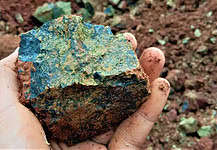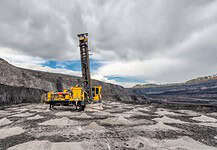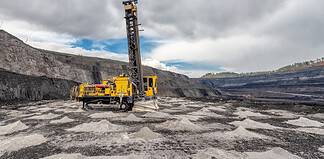All Images: Galaxy Resources
BY EMMA DAVIES
GROWTH in the lithium battery market is driving Galaxy Resources to ramp up production at its flagship Mt Cattlin mine in Ravensthorpe, WA and increase greenfields and brownfields exploration to meet future demand.
Galaxy Resources’ Mt Cattlin mine has been operational for two years and is now aiming to ramp up spodumene production to more than 210,000 dry metric tonnes per annum (dmtpa).
In the December quarter, the company produced only 33,780 dmt of spodumene concentrate at a lower than average reserve grade and recovery rate due to the majority of ore mined coming from a lower grade 2SW pit.
Galaxy also reported lower margins than the previous quarter, completing three shipments of lithium concentrate at an average cash margin of $US288 per dry metric tonne sold due to increased production costs.
However the companywas poised to finish FY19 on a high; scaling up its operations and increasing productivity for Q1 2019.“Galaxy is now focussed on optimising operations at Mt Cattlin in order to expand production volumes beyond those achieved in 2018 and is looking to achieve this following the implementation of a Yield Optimisation Program (YOP) at the plant,” Galaxy Resources managing director and chief executive Anthony Tse said.
“This will include the addition of an ultra-fines DMS circuit, a secondary floats re-liberation circuit and optical sorting circuits.
“Commissioning of these circuits commenced in the December quarter of 2018 and is nearing completion.”
Prior to the implementation of the YOP, the Mt Cattlin plant comprised two separate DMS lines that concentrated spodumene ore based on density and particle size (coarse and fines).
The ultra-fine material was not treated further (not included in the final product) and was stockpiled separately.
“The installation of an ultra-fines DMS circuit (a third line) will allow for the treatment of ore from even finer particles than currently treated, as well as the re-treatment of previously stockpiled ultra-fine material,” Mr Tse said.
“This will result in a greater overall recovery of spodumene through the plant.”
Each of the DMS circuits effectively concentrated spodumene via differences in the density of spodumene and waste materials.
The waste product separated from concentrated ore (floats) often still contained fine particles of spodumene that were not liberated due to the size fraction to which the particle was crushed.
“The re-liberation circuit takes this material, crushes it to a lower particle size and then recirculates it back through the plant,” Mr Tse said.
“The installation of the ultra-fines DMS circuit will effectively allow for greater overall liberation of spodumene from the ore material.
“The optical sorter circuits use differences in the colour of spodumene and waste material to further improve the quality of both the feed ore and final product, by removing the waste and impurity materials.”
Construction of the YOP circuits was completed in the December quarter of 2018 and commissioning was 85 per cent complete with completion, and the corresponding improved recoveries and production volume in the range of between 40,000 and 45,000 dry metric tonnes (dmt), expected from Q1 2019.
Revised Resource
An updated resource and reserve estimate for Mt Cattlin was released on 23 January and showed a 42 per cent increase in total Measured, Indicated and Inferred Resource tonnes to 16.7 million tonnes, at 1.28 per cent lithium oxide (Li2O) grade containing 214,400t of lithium.
Other highlights included a 16 per cent increase in total Measured and Indicated resource tonnes to 12.1mt, at 1.27 per cent Li2O grade.
Mr Tse said the mine plan and the mine life of the Mt Cattlin project was correlated to the defined project resource and would be revised based on the updated reserve model.
Galaxy had also recently obtained the necessary permits and approvals from the WA Department of Mines, Industry Regulation and Safety (DMIRS) to transition mining away from the Dowling and 2SW pits.
These areas had been the focus of mining since the recommencement of production at Mt Cattlin, and Galaxy has now commenced mining activities east of and on Floater Road with the aim of beginning to treat ore in Q1 2019.
“Mining in this region had always been contemplated as part of the mine plan,” Mr Tse said.
Market Outlook
The lithium sector growth was now dominated by the adoption of lithium-ion battery technology in everything from consumer electronics, portable electronics, to electric and plug-in hybrid electric vehicles, as well as mass energy storage systems.
Mr Tse said that lithium consumption was expected to grow a projected compound annual growth rate (CAGR) of between 15 per cent and20 per cent (2017-2025) and that the current consensus estimated project demand at between 800,000 tonnes and 1 million tonnes of lithium carbonate equivalent (LCE) demand by 2025.
“Key demand indicators through 2018 were reflective of the scope of consumption growth, as well as real demonstrated execution in the adoption of lithium-ion battery technologies,” he said.
“New Energy Vehicle (NEV) production in China totaled approximately 1.27 million units in calendar year 2018, while sales tolled approximately 1.26 million units, reflecting growth of 59.9 per cent and 61.7 per cent year-on-year respectively.
“Other key growth markets such as the US and Europe reported growth figures for plug-in vehicle sales of 81 per cent year-on-year (January-December) and 34 per cent year-on-year (January-November) respectively.
“China is targeting annual production of 2 million NEVs by 2020 and a 20 per cent penetration rate of NEVs by 2025.”
The rest of the world was also expected to follow suit, resulting in exponential demand growth for lithium with the key inflection point for accelerated growth to be realised within the next three to five years.
“This level of lithium-ion battery technology adoption is being supported by governments across the globe through mandated policy, such as emission reduction and electric vehicle production targets, as well as demonstrated investment in infrastructure and their associated services,” Mr Tse said.
The energy storage system (ESS) sector was also increasingly becoming a key component to the energy generation mix across the globe.
“Large ESS implementations have now emerged as a key resource in managing grid stability and supporting growing penetration of renewable energy by providing buffering and storage and this segment is projected to grow to 50GWh by 2020 and potentially 300GWh by 2025,” Mr Tse said.
The International Renewable Energy Agency (IRENA) estimated that more than a quarter of all global storage projects being built that it tracked, were based on the lithium-ion battery technology, which bodes well for Mt Cattlin’s future in the market.
Mr Tse said based on 2018 production, Galaxy was the world’s fifth largest producer of lithium raw materials on an LCE of resource basis.
“The Mt Cattlin team in Ravensthorpe will continue working towards enhancing operational output, increasing efficiencies and expanding the mine life of the project in order to ensure that Galaxy can continue to service the market as a primary producer of high-quality product,” he said.
“It is our core intention to maintain our leadership position within the lithium raw materials market and to potentially grow our market share through the continued optimisation of production at Mt Cattlin.
“Additionally, we will continue to progress our two world-class development assets, the Sal de Vida and James Bay projects in Argentina and Canada respectively.”









































